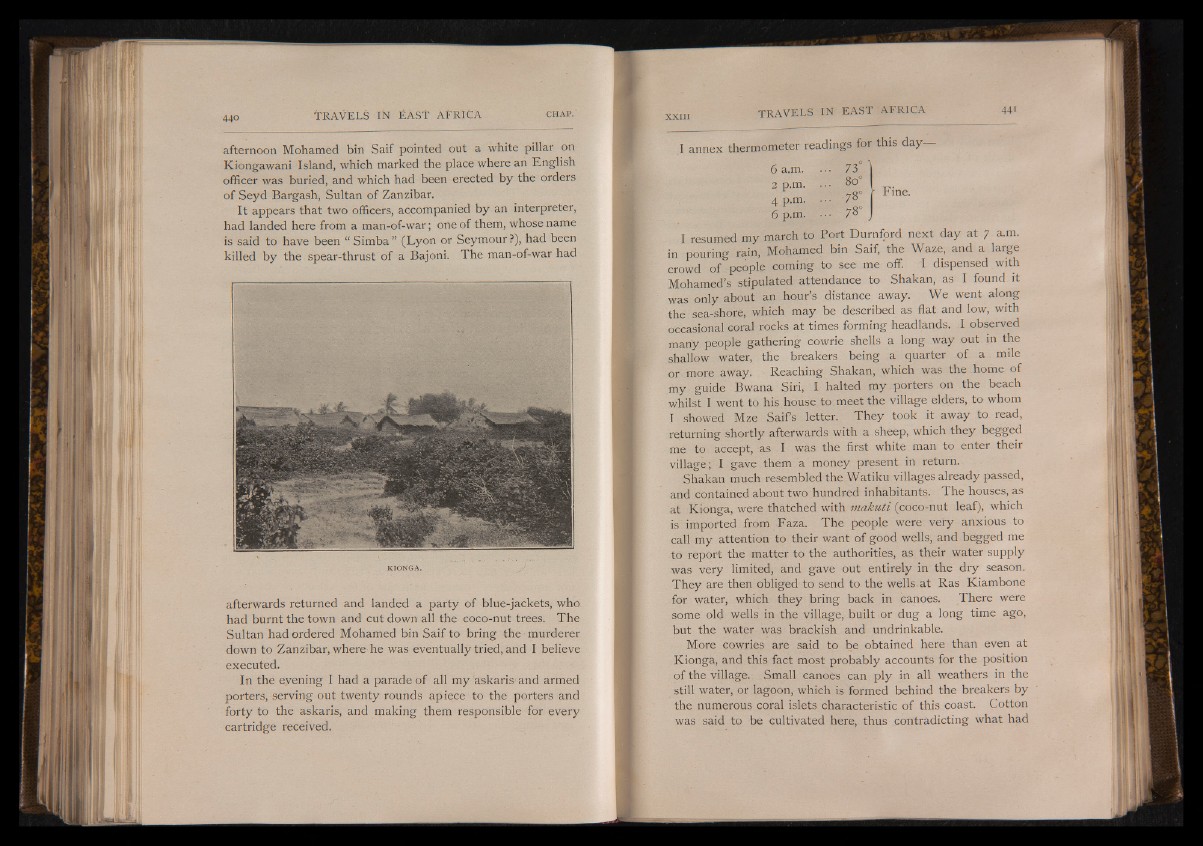
afternoon Mohamed bin Saif pointed out a white pillar on
Kiongawani Island, which marked the place where an English
officer was buried, and which had been erected by the orders
of Seyd Bargash, Sultan of Zanzibar.
It appears that two officers, accompanied by an interpreter,
had landed here from a man-of-war; one of them, whose name
is said to have been “ Simba ” (Lyon or Seymour ?), had been
killed by the spear-thrust of a Bajoni. The man-of-war had
KIONGA.
afterwards returned and landed a party of blue-jackets, who
had burnt the town and cut down all the coco-nut trees. The
Sultan had ordered Mohamed bin Saif to bring the murderer
down to Zanzibar, where he was eventually tried, and I believe
executed.
In the evening I had a parade of all my askaris and armed
porters, serving out twenty rounds apiece to the porters and
forty to the askaris, and making them responsible for every
cartridge received.
I annex thermometer readings for this day
6 a.m. ... 73
2 p.m. ••• 80
4 p.m. 7 8
6 p.m. ••• 7^°
Fine.
I resumed my march to Port Durnford next day at 7 a.m.
in pouring rain, Mohamed bin Saif, the Waze, and a large
crowd of people coming to see me off. I dispensed with
Mohamed’s stipulated attendance to Shakan, as I found it
was only about an hour’s distance away. We went along
the sea-shore, which may be described as flat and low, with
occasional coral rocks at times forming headlands. I observed
many people gathering cowrie shells a long way out in the
shallow water, the breakers being a quarter of a mile
or more away. Reaching Shakan, which was the home of
my guide Bwana Siri, I halted my porters on the beach
whilst I went to his house to meet the village elders, to whom
I showed Mze Saifs letter. They took it away to read,
returning shortly afterwards with a sheep, which they begged
me to accept, as I was the first white man to enter their
village; I gave them a money present in return.
Shakan much resembled the Watiku villages already passed,
and contained about two hundred inhabitants. The houses, as
at Kionga, were thatched with makuti (coco-nut leaf), which
is" imported from Faza. The people were very anxious to
call my attention to their want of good wells, and begged me
to report the matter to the authorities, as their water supply
was very limited, and gave out entirely in the dry season.
They are then obliged to send to the wells at Ras Kiambone
for water, which they bring back in canoes. There were
some old wells in the village, built or dug a long time ago,
but the water was brackish and undrinkable.
More cowries are said to be obtained here than even at
Kionga, and this fact most probably accounts for the position
of the village. Small canoes can ply in all weathers in the
still water, or lagoon, which is formed behind the breakers by
the numerous coral islets characteristic of this coast. Cotton
was said to be cultivated here, thus contradicting what had